Recently, Jim Collins, #1 bestselling author of Good to Great, talked to Inc. magazine on their podcast “What I Know” about meeting Steve Jobs and how he was a different leader when he came back to work for Apple a second time.
The difference, said Collins, was, “(Jobs) never lost the passion for what he was doing, and he was growing and he was learning.”
That learning contributed to what Collins called “Steve Jobs 2.0.” In his time away from Apple, Jobs elevated himself to a “Level 5” leader, exemplifying a concept Collins talks about in Good to Great. “It’s not about just being a genius with a thousand helpers, it’s about creating a culture of genius that ultimately doesn’t need the genius.”
“Level 5” refers to the highest level in a hierarchy of executive capabilities that Collins and his team identified during robust research of good and great companies. Leaders at the other four levels in the hierarchy can produce high degrees of success but not enough to elevate companies from mediocrity to sustained excellence.
Although other factors are in play when a company transitions from good to great, Collins states, “Good-to-great transformations don’t happen without Level 5 leaders at the helm. They just don’t.”
Level 5 leaders are not the larger-than-life characters most of us expect. Instead these transformative leaders possess a paradoxical mixture of personal humility and professional will. “They are timid and ferocious. Shy and fearless. They are rare — and unstoppable.”
Collins believes there is a category of people who have the capacity to evolve to Level 5.
“The capability resides within them, perhaps buried or ignored, but there nonetheless. And under the right circumstances — self-reflection, conscious personal development, a mentor, a great teacher, loving parents, a significant life experience, a Level 5 boss, or any number of other factors — they begin to develop.”
Explore your capacity for Level 5 leadership by learning more about Jim Collin’s books and concepts on his website, where he includes a library of articles about leadership.
MORE ABOUT JIM COLLINS
Jim Collins is a student and teacher of what makes great companies tick, and a Socratic advisor to leaders in the business and social sectors. Having invested more than a quarter century in rigorous research, he has authored or coauthored a series of books that have sold in total more than 10 million copies worldwide. They include Beyond Entrepreneurship (and the newly released Beyond Entrepreneurship 2.0 version), written as a roadmap for entrepreneurs and leaders of small-to-mid-sized enterprises who want to build enduring great companies provides enduring great companies, Good to Great, the #1 bestseller, which examines why some companies make the leap and others don’t; the enduring classic Built to Last, which discovers why some companies remain visionary for generations; How the Mighty Fall, which delves into how once-great companies can self-destruct; and Great by Choice, which uncovers the leadership behaviors for thriving in chaos and uncertainty.
*
Grow and learn with our Supervisory Leadership Certificate Program, which includes a diverse course curriculum that not only includes a core course “Development Yourself and Others” but also covers other critical topics like “Coaching for Performance,” “Change Management,” “Supervision and Human Resource Functions,” “Interpersonal Communication,” “Helping Your Team Achieve Organizational Management,” along with a Capstone Course that integrates all the learning and knowledge. Now enrolling for the spring session, starting in February.
*
RESOURCES:
Harvard Business Review. “Level 5 Leadership: The Triumph of Humility and Fierce Resolve,” Jim Collins, January 2001.
Inc., “The Lesson Management Guru Jim Collins Learned from Steve Jobs,” Christine Lagorio-Chafkin, January 2021.




